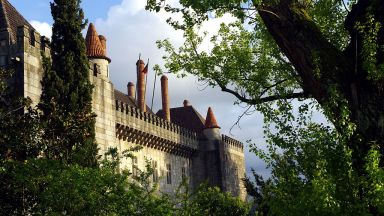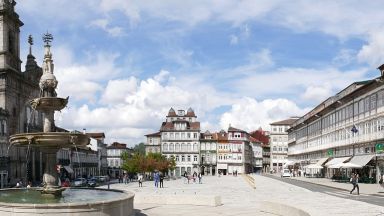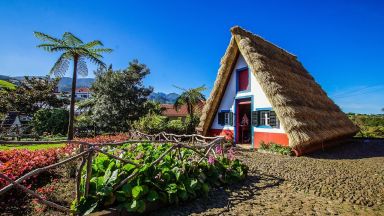Paço dos Duques de Bragança
Palace in Guimarães

The construction of the Palace of the Dukes of Bragança was initiated in the early 15th century, with a design based on French manor houses. It was commissioned by D. Afonso de Barcelos, the illegitimate son of D. João, Master of Avis and future king D. João I, who became the first Duke of Bragança. As the dukes moved their residence to the Palace of Vila Viçosa in Alentejo, the palace in Guimarães gradually deteriorated and eventually transformed into a military barracks in 1807.
In 1937, the palace began a restoration process, and on 24 June 1959, exactly 831 years after the Battle of São Mamede, the palace was revived to its original Norman-inspired Gothic grandeur. A contemporary art museum, featuring artwork donated to Guimarães by painter José de Guimarães, occupies the ground floor of the north wing. On the first floor, there are several huge rooms, used to exhibit various works of art, including 17th-century furniture, ancient weapon collections, and a remarkable set of four enormous tapestries depicting detailed scenes from the Portuguese arrival in Arzila, the siege of the city, and the capture of Tangiers. The original tapestries were discovered in Pastrana, near Madrid, and later moved to El Escorial Palace. The Spanish government never allowed the original tapestries to be returned to Portugal, so reproductions are now on display at the Ducal Palace.
The Paço dos Duques de Bragança appears in our Complete Guide to Visiting Guimarães!
This website uses affiliate links which may earn a commission at no additional cost to you!
Visiting Paço dos Duques de Bragança
10am-6pm
adult/child €5/free
Nearby Attractions
- Igreja de São Miguel do Castelo (0.1) km
Church in Guimarães - Castelo de Guimarães (0.2) km
Castle in Guimarães - Muralhas de Guimaraes (0.2) km
City Gate and City Walls in Guimarães - Convento de Santa Clara (Guimarães) (0.3) km
Convent in Guimarães - Rua de Santa Maria (0.3) km
Street in Guimarães - Largo dos Laranjais (0.3) km
Historic Building and Square in Guimarães - Fonte do Largo Dr. João da Mota Prego (Guimarães) (0.3) km
Fountain and Square in Guimarães - Praça de São Tiago (0.4) km
Square in Guimarães - Largo da Oliveira (0.4) km
Square in Guimarães - Alberto Sampaio Museum (0.4) km
Museum in Guimarães


